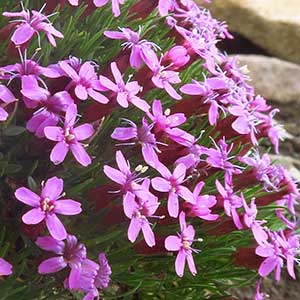Silene acaulis
Silene paradoxa
moss campion
Silene paradoxa
Leaves mostly basal, staying attached for many years, linear to linear-lanceolate, sessile, 4-10 mm. long, glabrous or scabrous.
Flowers single, from nearly sessile or with peduncles up to 4 cm. long, usually dioecious;
calyx tubular, 5-lobed, 3-10 mm. long, pinkish;
petals 5, pink to lavender, 8-12 mm. long, the claw about twice as long as the blade;
blade appendages 2, very small or lacking;
stamens 10;
styles 3.
Capsule 3-celled, opening by 6 teeth.
Silene acaulis
Silene paradoxa
Occurring in the Cascades and Olympic Mountains in Washington; Alaska to Oregon, east to the Rocky Mountains, and east across Canada to northeastern North America; circumboreal.
Occurring on Three Sisters Mountain in Whatcom County in Washington, where intentionally introduced and persists; not known elsewhere in North America.
- Local floras:
WA
- Local Web sites:
Flora NW,
PNW Herbaria
WildflowerSearch
iNaturalist (observations)
- LBJ Wildflower Center
- SEINet
- Plants of the World Online
- Encyclopedia of Life
- Wikipedia
- Google Image Search


